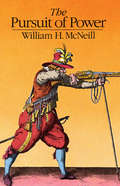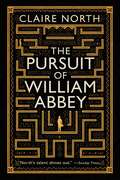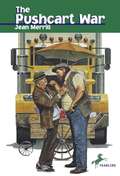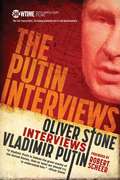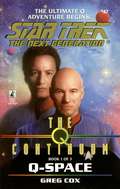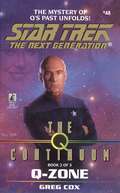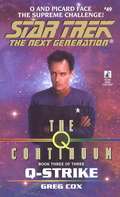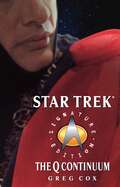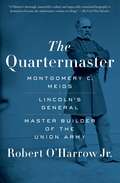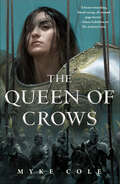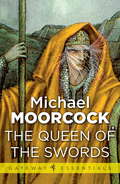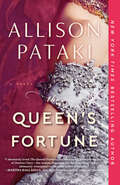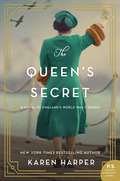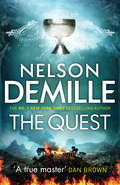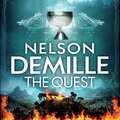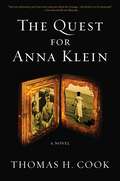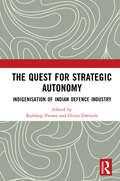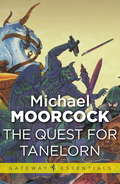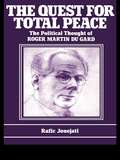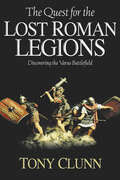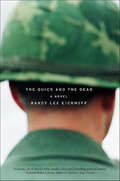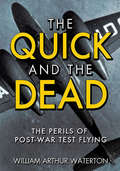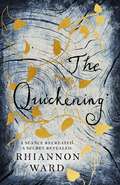- Table View
- List View
The Pursuit of Power
by William H. McneillIn this magnificent synthesis of military, technological, and social history, William H. McNeill explores a whole millennium of human upheaval and traces the path by which we have arrived at the frightening dilemmas that now confront us. McNeill moves with equal mastery from the crossbow--banned by the Church in 1139 as too lethal for Christians to use against one another--to the nuclear missile, from the sociological consequences of drill in the seventeenth century to the emergence of the military-industrial complex in the twentieth. His central argument is that a commercial transformation of world society in the eleventh century caused military activity to respond increasingly to market forces as well as to the commands of rulers. Only in our own time, suggests McNeill, are command economies replacing the market control of large-scale human effort. The Pursuit of Power does not solve the problems of the present, but its discoveries, hypotheses, and sheer breadth of learning do offer a perspective on our current fears and, as McNeill hopes, "a ground for wiser action." "No summary can do justice to McNeill's intricate, encyclopedic treatment. . . . McNeill's erudition is stunning, as he moves easily from European to Chinese and Islamic cultures and from military and technological to socio-economic and political developments. The result is a grand synthesis of sweeping proportions and interdisciplinary character that tells us almost as much about the history of butter as the history of guns. . . . McNeill's larger accomplishment is to remind us that all humankind has a shared past and, particularly with regard to its choice of weapons and warfare, a shared stake in the future."--Stuart Rochester, Washington Post Book World "Mr. McNeill's comprehensiveness and sensitivity do for the reader what Henry James said that Turgenev's conversation did for him: they suggest 'all sorts of valuable things.' This narrative of rationality applied to irrational purposes and of ingenuity cannibalizing itself is a work of clarity, which delineates mysteries. The greatest of them, to my mind, is why human beings have never learned to cherish their own species."--Naomi Bliven, The New Yorker
The Pursuit of William Abbey
by Claire NorthA hauntingly powerful novel about how the choices we make can stay with us forever, by the award-winning author of The First Fifteen Lives of Harry August and 84K.South Africa in the 1880s. A young and naive English doctor by the name of William Abbey witnesses the lynching of a local boy by the white colonists. As the child dies, his mother curses William. William begins to understand what the curse means when the shadow of the dead boy starts following him across the world. It never stops, never rests. It can cross oceans and mountains. And if it catches him, the person he loves most in the world will die.Gripping, moving, and thought-provoking, The Pursuit of William Abbey proves once again that Claire North is one of the most innovative voices in modern fiction.Previous books by Claire North:The First Fifteen Lives of Harry AugustTouchThe Sudden Appearance of HopeThe End of the Day84KThe GameshousePrevious books written as Kate Griffin:Matthew Swift novels:A Madness of AngelsThe Midnight MayorThe Neon CourtThe Minority CouncilMagicals Anonymous novels:Stray SoulsThe Glass God
The Pushcart War
by Jean MerrillThe pushcarts have declared war! New York City's streets are clogged with huge, rude trucks that park where they want, hold up traffic, and bulldoze into anything that is in their way, and the pushcart peddlers are determined to get rid of them. But the trucks are just as determined to get rid of the pushcarts, and chaos results in the city. The pushcarts have come up with a brilliant strategy that will surely let the hot air out of their enemies. The secret weapon--a peashooter armed with a pin; the target--the vulnerable truck tires. Once the source of the flat tires is discovered, the children of the city joyfully join in with their own pin peashooters. The pushcarts have won one battle, but can they win the war against a corrupt mayor who taxes the pins and prohibits the sale of dried peas?
The Putin Interviews: Oliver Stone Interviews Vladimir Putin
by Robert Scheer Oliver StoneWITH SUBSTANTIAL MATERIAL NOT INCLUDED IN THE DOCUMENTARY Academy Award winner Oliver Stone was able to secure what journalists, news organizations, and even other world leaders have long coveted: extended, unprecedented access to Russian President Vladimir Putin. The Putin Interviews are culled from more than a dozen interviews with Putin over a two-year span—never before has the Russian leader spoken in such depth or at such length with a Western interviewer. No topics are off limits in the interviews, which first occurred during Stone’s trips to meet with NSA whistleblower Edward Snowden in Moscow and most recently after the election of President Donald Trump. Prodded by Stone, Putin discusses relations between the United States and Russia, allegations of interference in the US election, and Russia’s involvement with conflicts in Syria, Ukraine, and elsewhere across the globe. Putin speaks about his rise to power and details his relationships with Presidents Clinton, George W. Bush, Obama, and Trump. The exchanges are personal, provocative, and at times surreal. At one point, Stone asks, “Why did Russia hack the election?”; at another, Stone introduces him to Stanley Kubrick’s 1964 Cold War satire "Dr. Strangelove," which the two watch together. Stone has interviewed controversial world leaders before, including Hugo Chavez, Fidel Castro, and Benjamin Netanyahu. But The Putin Interviews, in its unmediated access to one of the most enigmatic and powerful men in the world, can only be compared to the series of conversations between David Frost and Richard Nixon we now refer to as “The Nixon Interviews” of 1977. The book will also contain references and sources that give readers a deeper understanding of the topics covered in the interviews and make for a more robust reading experience.
The Puzzle of the Happy Hooligan
by Stuart PalmerIt's murder on a film set...'Will keep you laughing and guessing from the first page to the last' NEW YORK TIMESHildegarde Withers is just your average school teacher but with above-average skills in the art of deduction. She often finds herself investigating crimes led only by her own meddlesome curiosity, though her friends on the NYPD don't mind when she solves their cases for them. After plans for a grand tour of Europe are interrupted by Germany's invasion of Poland, Miss Withers heads to Los Angeles instead, where her vacation finds her working as a technical advisor on the set of a film adaptation of the Lizzie Borden story. But the producer's plans for an epic retelling of the historical killer's murder-spree are derailed when a screenwriter turns up dead...
The Q Continuum: The Q Continuum #1 (Star Trek: The Next Generation #47)
by Greg CoxThe unpredictable cosmic entity known only as Q has plagued Captain Jean-Luc Picard and the crew of the Starship Enterprise™ since their very first voyage together. But little is known of Q's mysterious past or that of the unearthly realm from which he hails. Now Picard must learn Q's secrets—or all of reality may perish!Ever since its discovery, the great galactic barrier has impeded humanity's exploration of the universe beyond the Milky Way. Now a brilliant Federation scientist may have found a way to breach the barrier, and the Enterprise is going to put it to the test. The last thing Picard needs is a return visit from an omnipotent troublemaker so, naturally, Q appears. But Q has more in mind than his usual pranks, and while the Enterprise struggles to defeat a powerful inhuman foe, Captain Picard must embark on a fantastic odyssey into the history of the Q Continuum itself, with the fate of the galaxy hanging in the balance.
The Q Continuum: The Q Continuum #2 (Star Trek: The Next Generation #48)
by Greg CoxThe puckish super-being called Q has bedeviled Captain Jean-Luc Picard and the crew of the Starship Enterprise™ since their first encounter at Farpoint Station. But little was known of Q's enigmatic past or that of the transcendent plane where he sometimes dwells. Now Picard must discover Q's secrets—for the sake of all that exists.While the Enterprise struggles to survive an alien onslaught, Captain Picard has been kidnapped by Q and taken on an astounding journey back through time to that immeasurably distant moment when the Continuum faced its greatest threat. But far more is at stake than simply the mysteries of the past, for an ancient menace is stirring once more, endangering the future of the galaxy, and neither Q nor Starfleet may be able to stop it!
The Q Continuum: The Q Continuum #3 (Star Trek: The Next Generation #49)
by Greg CoxThe mischievous creature who calls himself Q has subjected Captain Jean-Luc Picard and the crew of the Starship Enterprise™ to many of their strangest experiences. But little had been known of Q's curious existence or that of the advanced dimension from which he comes. But now Picard knows more than he ever dreamed about an ancient conflict whose consequences might spell the doom of the entire galaxy.The galactic barrier has fallen and Q's oldest enemy is free once more. Captain Picard and his crew find themselves in the middle of a cosmic war between vastly powerful entities. The future of the Federation may be at stake, but how can mere mortals turn the tide in such a superhuman battle? Picard has to find a way, or neither the Q Continuum nor the galaxy will survive.
The Q Continuum: The Q Continuum Book 2 (Star Trek: The Next Generation #48)
by Greg CoxThe unpredictable cosmic entity known only as Q has plagued Captain Jean-Luc Picard and the crew of the Starship Enterprise since their very first voyage together. But little was known of Q's mysterious past or of the unearthly realm from which he hails. Until now. A brilliant scientist may have found a way to breach the energy barrier surrounding the Milky Way galaxy, and the Enterprise is going to put it to the test. The last thing Captain Picard needs is a surprise visit from Q, but the omnipotent trickster has more in mind than his usual pranks. Kidnapping Picard, he takes the captain back through time to the moment the Q Continuum faced its greatest threat. Now Picard must learn Q's secrets -- or all of reality may perish!
The Quartermaster: Montgomery C. Meigs, Lincoln's General, Master Builder of the Union Army (Archeological Resource Survey Report #No. 20)
by Robert O'Harrow Jr.General Montgomery C. Meigs, who built the Union Army, was judged by Lincoln, Seward, and Stanton to be the indispensable architect of the Union victory. Civil War historian James McPherson calls Meigs "the unsung hero of northern victory."Born to a well to do, connected family in 1816, Montgomery C. Meigs graduated from West Point as an engineer. He helped build America's forts and served under Lt. Robert E. Lee to make navigation improvements on the Mississippi River. As a young man, he designed the Washington aqueducts in a city where people were dying from contaminated water. He built the spectacular wings and the massive dome of the brand new US Capitol. Introduced to President Lincoln by Secretary of State William Seward, Meigs became Lincoln's Quartermaster. It was during the Civil War that Meigs became a national hero. He commanded Ulysses S. Grant's base of supplies that made Union victories, including Gettysburg, possible. He sustained Sherman's army in Georgia, and the March to the Sea. After the war, Meigs built Arlington Cemetery (on land that had been Robert E. Lee's home). Robert O'Harrow Jr. brings Meigs alive in the commanding and intensely personal Quartermaster. We get to know this major military figure that Lincoln and his Cabinet and Generals called the key to victory and learn how he fed, clothed, and armed the Union Army using his ingenuity and devotion. O'Harrow tells the full dramatic story of this fierce, strong, honest, loyal, forward-thinking, major American figure.
The Queen of Crows (The Sacred Throne #2)
by Myke ColeMyke Cole, star of CBS's Hunted and author of the Shadow Ops series returns with book two of the Sacred Throne Trilogy: The Queen of Crows.In this epic fantasy sequel, Heloise stands tall against overwhelming odds—crippling injuries, religious tyrants—and continues her journey from obscurity to greatness with the help of alchemically-empowered armor and an unbreakable spirit.No longer just a shell-shocked girl, she is now a figure of revolution whose cause grows ever stronger. But the time for hiding underground is over. Heloise must face the tyrannical Order and win freedom for her people."A heart-wrenching, blood-racing, all-around page-turner. Spare, vivid and surprisingly sensual, with a small, fierce heroine who will stick in your mind and live in your soul."—Diana Gabaldon on The Armored SaintThe Sacred Throne Trilogy#1 The Armored Saint#2 The Queen of CrowsAt the Publisher's request, this title is being sold without Digital Rights Management Software (DRM) applied.
The Queen of the Swords (Gateway Essentials #409)
by Michael MoorcockThe Second Book of Corum: the Prince in the Scarlet Robe.Fresh from victory over the Chaos Lord, Arioch, Prince Corum must battle the forces of Xiombarg, the dreaded Queen of the Swords, whose armies are close to delivering control of five planes of existence to Chaos, the forces of Law all but defeated.Corum and his allies enter the fray, though the odds are stacked against them. Their only hope lies in locating the advanced weaponry of the fabled City in the Pyramid. But the City is besieged by the forces of Chaos - and the Chaos Lords are now sworn enemies of the Prince in the Scarlet Robe...
The Queen's Fortune: A Novel of Desiree, Napoleon, and the Dynasty That Outlasted the Empire
by Allison PatakiA sweeping novel about the extraordinary woman who captured Napoleon&’s heart, created a dynasty, and changed the course of history—from the New York Times bestselling author of The Traitor's Wife, The Accidental Empress, and Sisi. As the French revolution ravages the country, Desiree Clary is faced with the life-altering truth that the world she has known and loved is gone and it&’s fallen on her to save her family from the guillotine. A chance encounter with Napoleon Bonaparte, the ambitious and charismatic young military prodigy, provides her answer. When her beloved sister Julie marries his brother Joseph, Desiree and Napoleon&’s futures become irrevocably linked. Quickly entering into their own passionate, dizzying courtship that leads to a secret engagement, they vow to meet in the capital once his career has been secured. But her newly laid plans with Napoleon turn to sudden heartbreak, thanks to the rising star of Parisian society, Josephine de Beauharnais. Once again, Desiree&’s life is turned on its head. Swept to the glittering halls of the French capital, Desiree is plunged into the inner circle of the new ruling class, becoming further entangled with Napoleon, his family, and the new Empress. But her fortunes shift once again when she meets Napoleon's confidant and star general, the indomitable Jean-Baptiste Bernadotte. As the two men in Desiree&’s life become political rivals and military foes, the question that arises is: must she choose between the love of her new husband and the love of her nation and its Emperor? From the lavish estates of the French Riviera to the raucous streets of Paris and Stockholm, Desiree finds herself at the epicenter of the rise and fall of an empire, navigating a constellation of political giants and dangerous, shifting alliances. Emerging from an impressionable girl into a fierce young woman, she discovers that to survive in this world she must learn to rely upon her instincts and her heart. Allison Pataki&’s meticulously researched and brilliantly imagined novel sweeps readers into the unbelievable life of a woman almost lost to history—a woman who, despite the swells of a stunning life and a tumultuous time, not only adapts and survives but, ultimately, reigns at the helm of a dynasty that outlasts an empire.
The Queen's Secret: A Novel of England's World War II Queen
by Karen HarperIf you love Jennifer Robson or The Crown you will love New York Times bestselling author Karen Harper’s novel about Elizabeth, The Queen Mother. 1939. As the wife of the King George VI and the mother of the future queen, Elizabeth—“the queen mother”—shows a warm, smiling face to the world. But it’s no surprise that Hitler himself calls her the “Most Dangerous Woman in Europe.” For behind that soft voice and kindly demeanor is a will of steel.Two years earlier, George was thrust onto the throne when his brother Edward abdicated, determined to marry his divorced, American mistress Mrs. Simpson. Vowing to do whatever it takes to make her husband’s reign a success, Elizabeth endears herself to the British people, and prevents the former king and his brazen bride from ever again setting foot in Buckingham Palace. Elizabeth holds many powerful cards, she’s also hiding damaging secrets about her past and her provenance that could prove to be her undoing.In this riveting novel of royal secrets and intrigue, Karen Harper lifts the veil on one of the world’s most fascinating families, and how its “secret weapon” of a matriarch maneuvered her way through one of the most dangerous chapters of the century.
The Quest
by Nelson DeMilleMankind's greatest mystery lies in wait...Civil war rages in Ethiopia. A priest waits to die in a parched prison cell; he has not seen daylight for four decades. But then a mortar shell hits the compound, and the prisoner and his secret are free.Two reporters and a beautiful photographer save this wounded man, who tells them something too incredible to believe: the location of the Holy Grail. Thus begins an impossible quest that will pit them against murderous tribes, deadly assassins, fanatical monks, and ultimately, themselves. The Quest is a breakneck search for an ancient legend amid a dangerous jungle war - and no one's coming out unscathed.
The Quest
by Nelson DeMilleMankind's greatest mystery lies in wait...Civil war rages in Ethiopia. A man waits to die in a parched prison cell; he has seen daylight for four decades. But then a bomb hit hits the compound, and the prisoner and his secret are free.Two reporters, a beautiful photographer and a mercenary soldier save this wounded man, who tells them something too incredible to believe: the location of the Holy Grail. Thus begins an impossible quest that will pit them against murderous tribes, deadly assassins, fanatical monks, and ultimately, themselves. The Quest is a breakneck search for an ancient legend amid a dangerous jungle war - and no one's coming out unscathed
The Quest for Anna Klein
by Thomas H. CookOn the eve of WWII, a wealthy young New Yorker is drawn into an international plot by an alluring and dangerous woman: “Captivating.” —Kirkus ReviewsIt’s 1939 and the world is on the brink of war, but Thomas Danforth is in New York City living a charmed life. The well-traveled son of a wealthy importer, he’s in his twenties and running the family business, looking forward to a bright future. Then, during a dark, snowy walk along Gramercy Park, a friend makes a fateful request—and involves Thomas in a dangerous plot that could change the fates of millions.Thomas is asked to open up his secluded Connecticut mansion to a mysterious woman who will receive training in firearms and explosives. Thus begins an international scheme carried out by the captivating Anna Klein which will ensnare Thomas in more ways than one. When it all goes wrong and Anna disappears, he will travel far from home once again, but this time, into a war-torn world that is much more dangerous, in this story by an Edgar Award–winning author known for his “piercing thrillers” (Daily News, New York).“No other suspense writer takes readers as deeply into the heart of darkness as Thomas H. Cook.” —Chicago Tribune“Laced with dozens of intriguing historical anecdotes.” —Kirkus Reviews“Cook’s work is elegant, philosophical, and literary. This book is to be treasured, and is bound to earn him new readers. Grade A.” —The Plain Dealer
The Quest for Anna Klein: A Novel
by Thomas H. CookOn the eve of WWII, an international plot leads to a deadly obsession: &“Nobody tells a story better than Thomas H. Cook&” (Michael Connelly, New York Times–bestselling author of Two Kinds of Truth). It&’s 1939 and the world is on the brink of war, but Thomas Danforth is in New York City living a fortunate life. The well-traveled son of a wealthy importer, he&’s in his twenties and running the family business, looking forward to a bright future. Then, during a snowy evening walk along Gramercy Park, a friend makes a fateful request—and involves Thomas in a dangerous idea that could change the fates of millions. Thomas is to provide access to his secluded Connecticut mansion, where a mysterious woman will receive training in firearms and explosives. Thus begins an international plot carried out by the strange and alluring Anna Klein—a plot that will ensnare Thomas in more ways than one. When it all goes wrong and Anna disappears, he will travel far from home once again, but this time, into a war-torn world that is far more dangerous, in this story by an Edgar Award–winning author known for his &“piercing thrillers&” (New York Daily News). &“No other suspense writer takes readers as deeply into the heart of darkness as Thomas H. Cook.&” —Chicago Tribune
The Quest for Strategic Autonomy: Indigenisation of Indian Defence Industry
by Divya Dwivedi Kuldeep Verma Js SodhiThis book offers insights into India’s efforts to become self-reliant in its defence sector. Encompassing a wide range of subjects – such as policy frameworks, technological advancements, economic considerations, and strategic implications – the subject matter explores the diverse aspects of India’s defence industry indigenisation efforts. By gathering the insights of esteemed experts, scholars, and professors, the book also presents an examination of the obstacles and possibilities in this process.The aim of this book is to contribute to the ongoing discussion on the importance of a robust domestic defence industry in strengthening India’s national security, elevating its international standing, and reinforcing its ability to make independent strategic decisions.Print edition not for sale in South Asia (India, Sri Lanka, Nepal, Bangladesh, Pakistan and Bhutan)
The Quest for Tanelorn (Gateway Essentials #449)
by Michael MoorcockDorian Hawkmoon's dangerous quests through the multiverse have been successful and he has finally been reunited with his true love Yisselda, although his two children are still missing. Hawkmoon would move Heaven and Earth to find them - no idle boast when dealing with the multiverse - and soon finds himself on another quest. If he is to finally reunite his family, Hawkmoon must first find his way to the fabled city of Tanelorn...
The Quest for Total Peace: The Political Thought of Roger Martin du Gard
by R. JouejatiThis title available in eBook format. Click here for more information.Visit our eBookstore at: www.ebookstore.tandf.co.uk.
The Quest for the Lost Roman Legions: Discovering the Varus Battlefield
by Tony ClunnThe story of an ancient ambush that devastated Rome—and the modern-day hunt that finally revealed its location and its archaeological treasures. In 9 A.D., the seventeenth, eighteenth, & nineteenth Roman legions and their auxiliary troops under the command of Publius Quinctilius Varus vanished in the boggy wilds of Germania. They died singly and by the hundreds over several days in a carefully planned ambush led by Arminius—a Roman-trained German warrior adopted and subsequently knighted by the Romans, but determined to stop Rome&’s advance east beyond the Rhine River. By the time it was over, some 25,000 men, women, and children were dead and the course of European history had been forever altered. &“Quinctilius Varus, give me back my legions!&” Emperor Augustus agonized aloud when he learned of the devastating loss. As decades passed, the location of the Varus defeat, one of the Western world&’s most important battlefields, was lost to history. It remained so for two millennia. Fueled by an unshakable curiosity and burning interest in the story, a British Major named J. A. S. (Tony) Clunn delved into the nooks and crannies of times past. By sheer persistence and good luck, he turned the foundation of German national history on its ear. Convinced the running battle took place north of Osnabruck, Germany, Clunn set out to prove his point. His discovery of large numbers of Roman coins in the late 1980s, followed by a flood of thousands of other artifacts (including weapons and human remains), ended the mystery once and for all. Archaeologists and historians across the world agreed. Today, a state-of-the-art museum houses and interprets these priceless historical treasures on the very site Varus&’s legions were lost. The Quest for the Lost Roman Legions is a masterful retelling of Clunn&’s search to discover the Varus battlefield. His well-paced and vivid writing style makes for a compelling read as he alternates between his incredible modern quest and the ancient tale of the Roman occupation of Germany—based upon actual finds from the battlefield—that ultimately ended so tragically in the peat bogs of Kalkriese.</
The Quick and the Dead: A Novel
by Randy Lee EickhoffVietnam, 1966. Benjamin Wingfoot is the leader of a Special Operations Group stationed deep upcountry. He's taken on plenty of dangerous missions, but something about his latest assignment doesn't sit well with him. Summoned back to Saigon, "Wingo" is ordered to kill a local bar girl suspected of spying for the North--and make it look like the routine murder of a prostitute.Right away, he suspects that there is more to this mission than he is being told. War may be hell, but, as Wingo struggles to uncover the truth amidst the corruption of wartime Saigon, he soon learns that even darker trials await him--and that the price of holding onto his soul may be more than any one man can endure . . . .At the Publisher's request, this title is being sold without Digital Rights Management Software (DRM) applied.
The Quick and the Dead: The Perils of Post-War Test Flying
by William Arthur WatertonA pilot&’s behind-the-scenes account of test flying with British aircraft organizations and manufacturers in the early years of the Cold War. Written from the pilot&’s viewpoint, with refreshing candor and honesty, this account details what really went on behind the scenes in the defense world of the 1950s. After serving in World War II, the author continued his flying career, but to his dismay, found that quality was sometimes neglected when developing aircraft—leading to lives lost. Mainly centering on his work with the mighty Gloster Meteor and the Javelin interceptors, The Quick and the Dead is an astonishing report that sparked controversy upon its first publication. It was seen as a wake-up call at a time when British ingenuity and prowess were being overtaken by the Americans and Russians—and offers an astonishing insight into the history of the British aircraft industry.
The Quickening
by Rhiannon Ward'If you like gothic mystery, buckle up! This atmospheric read has it all' Woman magazine'An historical novel dripping with menace'Shari Lapena, author of The End of Her***********England, 1925. Louisa Drew lost her husband in the First World War and her six-year-old twin sons in the Spanish Flu epidemic of 1918. Newly re-married and seven months pregnant, Louisa is asked by her employer to travel to Clewer Hall in Sussex where she is to photograph the contents of the house for auction.She learns Clewer Hall was host to an infamous séance in 1896, and that the lady of the house has asked those who gathered back then to come together once more to recreate the evening. When a mysterious child appears on the grounds, Louisa finds herself compelled to investigate and becomes embroiled in the strange happenings of the house. Gradually, she unravels the long-held secrets of the inhabitants and what really happened thirty years before... and discovers her own fate is entwined with that of Clewer Hall's.For fans of The Silent Companions, The Little Stranger and The Familiars, an exquisitely crafted and compelling mystery that invites the reader in to the crumbling Clewer Hall to help unlock its secrets.**********'Utterly brilliant... full of secrets and deliciously creepy'Lisa Hall, author of The Perfect Couple'A spooky treat, which had me turning the pages faster and faster'Cass Green, author of In a Cottage in a Wood
